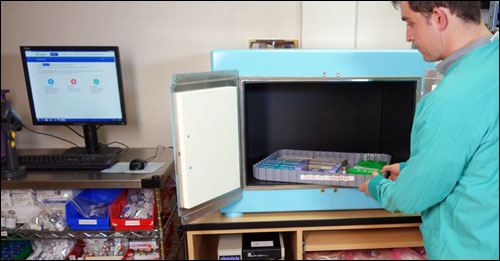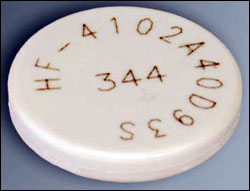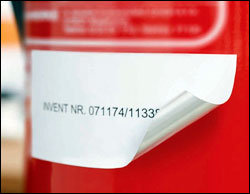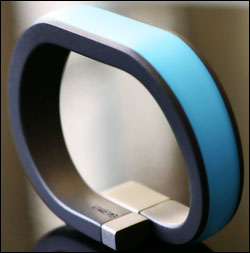The following are news announcements made during the past week by the following organizations:
Fletcher Allen Health Care, Kit Check;
Infratab;
Smartrac;
HID Global;
Stryker Europe, SATO; and
Maxim Integrated; and
Everykey.
Fletcher Allen Health Care Tracks Pharmaceuticals Via Kit Check’s RFID Solution
Fletcher Allen Health Care, a medical center and hospital in Burlington, Vermont, in alliance with the University of Vermont, is using Kit Check‘s automated hospital pharmacy kit processing and medication tracking solution to help ensure patients receive medications that are safe and effective.
Fletcher Allen Health Care, which includes a 562-bed academic medical center and three other major campuses and 30 patient-care sites, manages more than 700 pharmacy medication kits (one kit can hold up to 200 medicines) of 33 varieties daily, and had been doing so manually. But the manual restocking was inefficient and prone to human error, according to Kit Check. Now, Fletcher Allen Health Care is using RFID and has reduced the time it takes to replenish kits to mere seconds, while eliminating kit errors due to expired drugs.
Kit Check’s scanning solution features an RFID reader that automatically captures the tag’s ID and associates it with the appropriate kit. This eliminates the practice of manually recording each kit’s seal serial number, and also creates a detailed audit trail. Kit Check’s solution is also used to identify each individual medication within a pharmacy kit. Kits are placed on trays tagged with EPC Gen 2 passive ultrahigh-frequency (UHF) RFID tags, and are put into the Kit Check enclosed reader. Every item is also tagged with a similar tag. Fletcher Allen is using tags supplied by Avery Dennison.
Fletcher Allen has implemented three Kit Check scanning stations at its medical center—two at the main pharmacy and one in the OR pharmacy—as well as a fourth at a satellite ambulatory center. The organization has worked with Kit Check to convert 766 pharmacy trays and kits to support RFID; the process requires four steps. Each kit type is created in the software, which designates the medication quantities and volumes associated with each type, and alternate medications are identified to address shortages. Next, an RFID tag is applied to each kit and matched to a kit type, and an RFID tag is applied to each kit medication. Characteristics, such as lot number, expiration date and National Drug Code (NDC), are then associated with the tag. Finally, tagged medications are added to the kits and are associated with each kit when placed in Kit Check’s scanning station.
During the first six months of using the Kit Check solution, Fletcher Allen tracked nearly 130,000 medications and restocked pharmacy kits more than 10,000 times, according to Kit Check. The efficiency improvement is saving the pharmacy staff approximately 14 hours of manual work daily, the company reports. Fletcher Allen also has been able to manage recalls and drug shortages easily and efficiently, in addition to eliminating hundreds of man-hours that were previously required to resolve these issues that arise with increasing frequency.
Infratab Introduces Smartphone Sensor Tags for Monitoring Perishables
Infratab, a provider of sensors and software to monitor, track and communicate a perishable’s condition throughout the supply chain, has introduced two new RFID sensor battery-assisted passive tags as part of its Freshtime temperature-tracking solution.
The two new tags—the Freshtime NFC and the Freshtime Dual—are intended for use in monitoring and recording the shelf life and environmental temperatures of temperature-sensitive goods. Both can operate in a temperature range of -30 degrees Celsius to +70 degrees Celsius (-22 degrees Fahrenheit to +158 degrees Fahrenheit).
The Freshtime NFC can be read by a Near Field Communication (NFC)-enabled smartphone (the older tags in the Freshtime product line require an RFID EPC Gen 2 reader to set up the tag and retrieve the data stored on it). The Freshtime NFC tag combines NXP’s NTG I²C chip with a battery-powered sensor, and supports a read range of up to 10 centimeters (4 inches). Prospective users include farmers, small growers, businesses and restaurateurs.
The Freshtime Dual tag is made with two RFID chips (NXP’s Ucode I²C and NFC RFID NTAG I²C models), enabling it support ultrahigh-frequency (UHF) EPC Gen 2 and high-frequency (HF) NFC RFID technologies. The tag can be attached and started in the field (using only a smartphone) and then be read by packinghouses, consumer brands and retailers via EPC Gen 2 devices. The UHF RFID chip provides an operating distance of up to 10 meters (30 feet) with battery assistance, in order to increase range upon command, while the NFC tag provides a range of up to 10 centimeters (4 inches).
Infratab says it has other tags in the works: one for oyster sacks, capable of withstanding both the oyster and the ocean, and another for frozen goods, which lets handlers know whether a product has thawed and been refrozen.
Smartrac Announces Thin On-Metal RFID Label, New Laundry Tag
Smartrac has announced two new RFID tags: an on-metal ultrahigh-frequency (UHF) tag that measures just 600 micrometers in thickness, and a new smaller, industry-compliant laundry tag. The On-Metal Tag is intended for tagging metal objects and surfaces, as well as challenging non-metal objects, and is suitable for industrial steel pallets, automotive parts, paint pails and other similar items, according to Smartrac. Measuring 98 millimeters by 43 millimeters (3.86 inches by 1.69 inches) in length and width, the tag supports the EPC Gen 2 and ISO 18000-6C standards, leverages Impinj‘s Monza 4QT integrated circuit supporting 128 bits of Electronic Product Code (EPC) memory and 512 bits of user memory, and can be printed and encoded onsite using standard RFID printers.
The new On-Metal Tag is made of white polyethylene terephthalate (PET), Smartrac reports, making it thin, soft and flexible, so it can be affixed to curved and flat surfaces. The tag has a read-range of up to 3.5 meters (11.5 feet) and is available in versions designed for the ETSI (for Europe) and FCC (for America and Asia) frequency bands. The product is delivered in wet format on a single-row, 500-unit reel, with reliable adhesion for demanding surfaces, Smartrac reports. In addition, the tag is compliant with the ISO 9001:2008 Quality Management and ISO 14001:2004 Environmental Management specifications.
The new Smartrac Laundry Tag, Smartrac indicates, is designed for the rough environmental conditions encountered in the laundry-management industry, featuring a polyphenylene sulfide (PPS) housing to withstand water immersion, high temperatures of up to 200 degrees Celsius (392 degrees Fahrenheit), pressure and chemicals. Made with EM Microelectronic‘s EM4033 chip supporting the ISO 15693 and ISO 18000-3 standards, the new 13.56 MHz tag measures 16.1 millimeters (0.63 inch) thick and has a 64-bit unique identifier (UID).
The laundry tag is equipped with an anti-collision feature so individual tags can be read even when multiple tagged garments are stacked together tightly, Smartrac reports. It has a read distance of up to 70 millimeters (2.8 inches) within the HF frequency band, and can be sewn into linen sheets, garments and other laundry items.
HID Global’s NFC Tag Pilot Demonstrates “Proof of Presence” for Home Care
HID Global has announced the results of an ongoing pilot deployment designed to test its HID Trusted Tag Services and Near Field Communication (NFC) high-frequency (HF) passive RFID tags, known as the HID Trusted Tags, which are tamper-proof and feature unique security and privacy attributes. The pilot, being conducted with Integrity Home Care, a provider of home-based care services, is designed to test HID Trusted Tag Services’ ability to provide real-time authentication of caregiver visits via smartphones. According to HID Global, the pilot illustrates that NFC technology and HID Trusted Tag Services, in particular, are effective mechanisms for location authentication, which is the critical first step in maintaining compliant documentation of patient encounters. Partnering in the pilot program is Dial-N-Document, which provides software for verifying caregiver visits and documenting employee activities.
For the pilot, Integrity Home Care’s case managers affixed HID Trusted Tags to light switches within 15 patients’ homes, and five caregivers were issued NFC-enabled smartphones. Upon arrival at a patient’s home, a participating caregiver taps the phone to create a secure connection for authentication. If the tag is authenticated, the Dial-N-Document system captures its ID number and transmits that information directly to Integrity’s billing payroll and scheduling software, thereby providing “proof of presence” and an auditable Electronic Visit Verification (EVV) record of the caregiver having visited that home. The preliminary results of the pilot to date have yielded a 100 percent authentication accuracy rate, according to HID Global, and have demonstrated that the use of HID Trusted Tag Services increased caregiver productivity by eliminating up to 30 seconds from each check-in.
The company reports that its Trusted Tag Services, when integrated with a documentation platform like Dial-N-Document, complies with the EVV requirements for home health agencies enacted by several states as a condition of Medicaid participation in response to rampant billing fraud. In addition to providing an indisputable and auditable EVV record for agencies to use for billing and reimbursement, the company says, HID Trusted Tag Services integrates seamlessly into most clinical and administrative management software systems for real-time data transmissions that enable faster and more accurate claims processing and advanced analytics.
The pilot is still ongoing, according to Mark Robinton, the manager of technology innovation for HID’s strategic innovation team. “We’re continuing to test additional tag form factors and user experiences to make it commercial ready,” he states. “We’re making some adjustments with Dial-N-Document as we go, but the plan is for them to use it in a production setting early 2015.”
HID Global first unveiled its HID Trusted Tag in 2013 (see HID Global Offers Security for NFC and HID Trusted Tag Offers Secure NFC Connection Without App). The tag works with HID Global’s Trusted Tag Services that include back-end software and servers. The back-end systems authenticate each tag read before sharing data with an individual’s smartphone or other NFC reading device. Only HID Global’s Trusted Tag, with its own chip and firmware, can operate with the Trusted Tag Services. The tag’s internal software employs HID’s Seos technology, which has the ability to generate a one-time password amounting to a specific version of a URL that will not be used more than once for that tag. That URL must then be verified during each read event, by the Trusted Tag Services software running on HID Global’s cloud-based server, before it can transmit data to an NFC reading device.
Stryker Europe Expands Adoption of SATO’s PJM RFID Technology
Medical device manufacturer Stryker Europe has extended its use of RFID to its Swedish distribution center. The DC has adopted SATO‘s Phase Jitter Modulation (PJM) RFID technology, according to SATO and its health-care partner, Altrax Group, a traceability solutions provider based in the United Kingdom. The PJM technology being used by the DC was provided by Altrax. Stryker Europe has previously implemented the technology at its main distribution centers in the United Kingdom, France, Germany, Spain, Belgium and Italy, following deployments in Australia and New Zealand (see RFID News Roundup: Orthopedic Implant Company Stryker Rolls Out SATO’s PJM RFID Solutions Across Europe). PJM RFID is designed to quickly and accurately identify large volumes of tagged items stacked or stored in any physical orientation, according to SATO and Altrax Group.
SATO purchased Magellan Technology Pty Ltd., which invented the PJM RFID technology, in December 2013 (see SATO Acquires Magellan Technology). The company says it is now conducting research into and development of the PJM technology, while expanding its business of implant logistics management solutions in Asia and Europe.
Maxim Integrated Unveils NFC RFID Chip With an I²C interface
Maxim Integrated has announced a new Near Field Communication (NFC) RFID chip that combines an NFC RFID interface (compliant with the ISO 15693 standard) with an I²C interface, so designers can perform secure wireless data communication on their embedded systems without requiring the host microcontroller. The MAX66242 DeepCover Secure Authenticator enables the collection of system data from portable devices, even when the main energy source on the master device is not functional. Suitable for a variety of applications, the MAX66242 is especially useful for applications that require additional external functionality, but that lack the necessary space to place a connector, such as the secure, wireless transfer of medical data or asset tracking, according to Maxim Integrated.
The MAX66242 does not require an external power source. Instead, it integrates an energy-harvesting capability that can be used to power surrounding chips (such as a temperature sensor) to gather data from them. The energy-harvesting capability is connected via the I²C interface, and complements the existing power source in battery-powered devices, thereby extending overall battery life. It features an integrated SHA-256 cryptographic engine that provides symmetric challenge-and-response authentication based on a secret key for data downloads.
The MAX66242’s I²C interface port can operate as a master port or a slave port for secure data exchanges, and the chip comes with multiple memory-programmable options which let a user configure a secure master/slave system and set usage limits using the electrically erasable programmable read-only memory (EEPROM) emulation mode to create nonresettable counters. Designers can also utilize the MAX66242 to set up Wi-Fi or Bluetooth connections as a means of securely storing the pairing codes, Maxim Integrated reports; it then provides security for access control and tracking, system alert and wakeup, and the authentication of medical sensors for the secure transfer of personal data.
NXP Semiconductors offers a similar chip, the NTAG I²C (see RFID News Roundup: NXP Announces Commercial Release of NTAG I²C Chip).
Everykey Begins Kickstarter Campaign for Its Bluetooth Wristband
Everykey, which is developing a Bluetooth Smart wristband capable of unlocking doors, smartphones, tablets and laptops, as well as serving as a password-management tool for website logins, has officially kicked off a month-long Kickstarter campaign to fund production. Soon after the Kickstarter campaign closes on Nov. 29, the company plans to release a software development kit (SDK) for integrating Everykey with electronic locks. “Although we haven’t yet announced any official partners in this area, we do have interest,” says Christopher Wentz, Everykey’s CEO.
Available in a variety of colors, Everykey serves as a universal access device for any electronic device requiring a physical key or password. When it is within range—up to 3 meters (9.8 feet)—of such a device, the wristband will allow a user to bypass that device’s password or physically unlock it automatically, thus eliminating the need for passwords and keys, according to Everykey. It is also designed to store a password keychain, which can be used to log the user into his or her online accounts when the keychain is close to one of the devices. If the wristband moves out of range, the company notes, the device automatically re-enables security mechanisms so that it is safe and secure when out of trusted hands.
Everykey utilizes military-grade encryption, allowing only access to a user’s personal property and accounts, Wentz says. Like a credit card, he adds, the Everykey can be instantly disabled if lost or stolen.
The Kickstarter campaign will fund the first run of production. Current funding levels are $50 (one Everykey wristband in any available color), $90 (two Everykey wristbands in any available colors), $160 (four Everykey wristbands in any available color), $200 (one Everykey developer circuit board and early access to the Everykey SDK), $350 (10 Everykey wristbands in any available colors), and $500 (enabling a participant to visit the Everykey office in Cleveland, Ohio, meet the team, sit down with the chief designer and create an Everykey wristband in a custom color combination of the user’s choice). The Everykey is expected to retail at a cost of $100 per wristband.
The Everykey is water-resistant and has a flexible silicon exterior with a lightweight flexible metal skeleton for shape retention. It supports Mac OS, Windows, Android and iOS (for which it requires Jailbreak) and is compatible with the Google Chrome, Firefox and Safari Web browsers. It has a lithium-polymer battery rechargeable via a micro USB to USB cable that can be used with a computer or a power adaptor. The battery provides up to 30 days of life.





